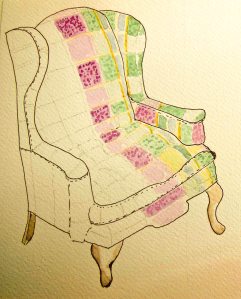
By Kathryn MacDonald
Quinte Arts Council
On a cool afternoon last fall, I met Daniel Fobert at Gallery 121 on Bridge Street East in downtown Belleville, where he was exhibiting two oil paintings.
One of Fobert’s greatest strengths is the narrative in his paintings. In Kensington after the Rain, the foreground is taken up by a man gazing at a cell phone, while two friends look on. Behind them, people go about their daily business beneath colourful awnings. Imagine the story.
In the second painting exhibited at Gallery 121, a colourful nude fills the canvas. Here the oils dance in bright rainbow hues. In Untitled, a portrait of an unnamed woman, we have an example of Fobert’s balanced use of complementary colour.
He tells me that his greatest challenge “is to feel that what I do is relevant in the face of a world where everything is non-representational.”

Abstract expressionism has been a dominant trend in Western art since the 1950s led by artists such as Jackson Pollock. Essentially, it defines non-representation work that strives to show the interior energy of experience rather than the outward image. Fobert adds even “[Jean-Paul] Riopelle returned to representational work after developing his renown in abstract expressionism.”
To compose the scene, Fobert uses photography as a guide to street paintings.
He doesn’t copy them; rather, he says, “I translate the photographed scenes into my composition.”
Daniel’s paintings demonstrate his drawing skill and his strength of composition. He also successfully achieves a sense of atmosphere or mood, a quality that is reminiscent of colourful expressionist artists such as LeRoy Nieman, whose name sports fans are especially likely to recognize for his paintings of athletes and sporting events.
Fobert began painting in high school, which is when he decided to “pursue an art career.” After studying graphic arts at Sheridan College—a wide-ranging program that included such courses as life drawing, print making, and colour theory—Fobert became involved with Toronto-based Screen Art Products.
There he was mentored by the owner, Ira Noble, who had studied with Arthur Lismer of Canada’s famous Group of Seven. Fobert eventually became co-owner of the company with his life-partner Mervin Patey. Among their clients were the Art Gallery of Ontario, the Royal Ontario Museum, and the Aga Khan Museum. During this period, Fobert “kept his creative spirit alive” by participating in Artists 25, a non-profit artists’ cooperative in Toronto.
A few years ago, Fobert “came home” to the Quinte region. “Part of my retirement goal is giving back,” he says. He is an active member of Gallery 121, the Baxter Art Centre, and the Quinte Arts Council.
To see more of Daniel Fobert’s work or to be in touch, please visit his website: danielfobert.com. You can find him on Facebook and Twitter as well.


































